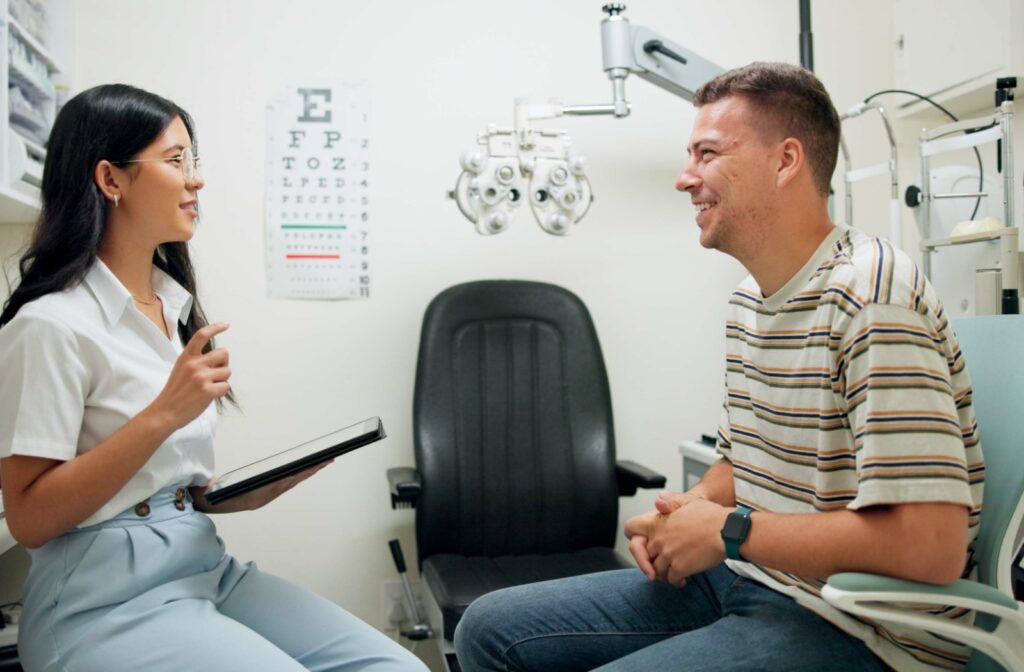Regular eye exams are an important part of preventive care and general well-being, but the financial aspect o can be overwhelming and confusing. You may be wondering whether you have insurance coverage for eye exams for yourself or your family.
According to the Washington State Health Care Authority, some eye care services are covered by Apple Health (Medicaid). Depending on your individual plan or the coverage offered by your employer, you may also have access to vision benefits. However, it’s important to understand what kind of exam your plan covers.
Here’s the key distinction:
- Vision coverage typically includes routine eye exams to check your prescription for glasses or contact lenses, as well as basic eye health screenings.
- Medical insurance usually covers exams and treatment for specific eye health concerns like infections, injuries, or chronic conditions (e.g., glaucoma, diabetic retinopathy).
This can be a confusing area for patients, so if you’re unsure whether your appointment is considered “vision” or “medical,” don’t hesitate to ask your optometrist or contact your insurance provider for clarification.
Note that the content of this blog is based on information gathered at the time of the blog’s publication. Because insurance coverage is prone to changing over time, you should contact your insurance provider for up-to-date and accurate information on what, exactly, they cover.
Health Insurance & Eye Exams in Washington
In general, Medicare doesn’t cover routine eye exams, though some Medicare Advantage Plans (Part C) offer extra benefits such as vision care. Medicaid coverage, on the other hand, depends on individual states, but children and youth enrolled in Medicaid are entitled to vision care services.
The following are examples of common health plans available in Washington and what they cover when it comes to vision care.
Apple Health (Medicaid)
- Coordinated Care: In the Washington Apple Health Plan, a free yearly eye exam is offered for members under 21 years old. Members who are 21 years and over receive a free eye exam once every 24 months.
- Community Health Plan of Washington: Coverage (without copay) is available for adults aged 21 and over for one routine eye exam every 24 months. Exams are through VSP’s provider network. Youth ages 20 and under receive 1 covered eye exam per year.
- UnitedHealthcare Community Plan of Washington: The Washington Apple Health (Medicaid) plan offers benefits for adult eye exams once every 24 months. Youth 21 and under are offered benefits for eye exams once every 12 months.
- Wellpoint Washington: The Apple Health (Medicaid) program offers members free or low-cost coverage of health services, including eye exams.
Other Insurance Plans
- Aetna: Three tiers of vision care plans are offered; eye exams are covered with various copay amounts.
- Guardian: Plan availability is different in every state, but Guardian offers individual vision plans that include yearly eye exams for a $15 co-pay.
- Providence Health Plan: The “Connect” plans for individuals and families include full coverage for children’s eye exams and coverage for adults with a co-pay. Other plans, such as the “Columbia” plan, only cover eye exams for children.
- VSP Vision Care: The “Standard” individual vision plan offered by VSP Vision Care covers eye exams with a copay. There is also an “EyewearOnly” vision plan.
If you receive health insurance through your employer, contact your plan’s administrator or your human resources department for more information.

Recommendations for Eye Exams
Regular eye exams are important, even for people with healthy vision. That’s because a comprehensive eye exam can catch early warning signs of a problem that may not show obvious symptoms at early stages. Eye exams can also detect systemic conditions like hypertension, diabetes, and some cancers.
The American Optometric Association recommends the following eye exam frequencies for low-risk patients:
- Infants and toddlers up to age 2: One eye exam between 6 and 12 months of age
- Young children between ages 3 and 5: At least 1 comprehensive eye exam
- Youth ages 6 to 17: One eye exam before first grade, and then one exam a year
- Adults aged 18 to 64: At least once every 2 years
- Older adults aged 65 and up: At least once a year
People at increased risk, including those with a family history of eye disease, certain underlying health conditions (such as diabetes), and very high refractive errors may require more frequent check-ups. Ask your optometrist for personalized advice.
What Happens During an Eye Exam
Your optometrist may do the following tasks during a comprehensive eye exam:
- Test your visual acuity: This may involve reading charts with letters at various distances.
- Measure your cornea: Also known as keratometry, this test is important for determining your contact lens fit.
- Test refraction: Your optometrist may use an instrument called a phoropter and have you look through a series of lenses. This test determines what lens power is required for nearsightedness or farsightedness.
- Check your eye health: Your optometrist may explore the health of the structures in your eye using a variety of instruments and technologies. Sometimes, drops are used to dilate the pupils.
Eye Exams at Precision Eye Care
Getting an eye exam isn’t just about updating your eyewear prescription. It’s a chance to screen your eyes for conditions and intervene as early as possible. You use your eyes every day for work, play, and everything in between, so consider getting them checked regularly by an optometrist.
Are you due for an eye exam? Precision Eye Care offers adult and senior eye exams, children’s eye exams, and eye exams for patients with diabetes. We also accept many different insurance plans. Contact us today to book your next appointment.





